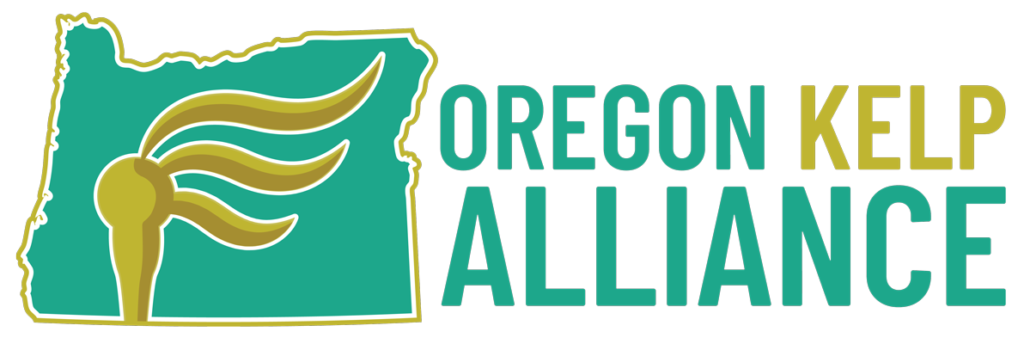Oregon Kelp Alliance scientist Dr. Sara Hamilton recently visited partners at Moss Landing Marine Labs (MLML) in Moss Landing, CA, to learn more about culturing bull kelp for restoration. Culturing is the process of growing something for a specific purpose and can be done in the ocean (mariculture), or in lakes or land-based tanks (aquaculture). Dr. Hamilton was lucky enough to meet with Andrew Kim and Bennett Bugbee, a research technician and graduate student in the Graham Lab at MLML respectively, who have mastered the science (and art) of bull kelp culturing. She learned about the process of inducing kelp sori, the reproductive part of the kelp, to release their reproductive material, called zoospores. Once released, these zoospores float around and eventually settle, where they grow into the tiny reproductive life stages of kelp, known as gametophytes (producing gametes). These gametophytes are either male or female, and will release eggs and sperm into the water column. Once the eggs and sperm meet and fertilize, they will settle and grow into a kelp sporophyte (producing spores), which is what we know as bull kelp – clear as typical water visibility on the Oregon coast?
Find out more about bull kelp here – https://bullkelp.info/characters/bull-kelp
The whole process isn’t as easy or straightforward as it sounds. It requires specific water temperatures, light levels, and flow conditions to allow the different life stages to develop, settle, and grow. By partnering with and learning from MLML, ORKA hopes to bring this new and innovative practice to Oregon. This process is important for ORKA as it will allow us to grow adult bull kelp in tanks on land to be used in our restoration efforts on the coast. With an ample supply of kelp growing and at the ready, ORKA will be able to plant these kelps at our restoration sites to help re-establish wild populations. In combination with concerted efforts to remove purple urchins from certain areas at specific times, as well as supporting the recovery of sunflower sea stars, the main predator of urchins, ORKA aims to bring back kelp forests to critical habitats along the Oregon coast.
Left: Bennett Bugbee shows bull kelp cultured in land-based tanks at Moss Landing’s aquaculture facilities. Right: A red light cooler in the Graham lab designed to keep juvenile kelps in arrested development until they are needed for cultures.
While in Moss Landing, Dr. Hamilton also visited the Sunflower Sea Star Lab, a non-profit dedicated to reintroducing sunflower sea star (Pycnopodia helianthoides) to California waters. There she was treated to a tour of their captive breeding facilities where about 30 juvenile sunflower stars are being raised. These sunflower sea stars are from a cohort of stars spawned from two captive adult sunflower sea stars at the Birch Aquarium in San Diego. They’ve grown quite a bit in the 9 months since they were spawned, indicating that when well fed, sunflower sea stars can reach up to 5-6 cm in diameter in less than a year. The folks at the Sunflower Sea Star Lab have been experimenting with what to feed these captive stars, and, excitingly, have found that they are ravenous for juvenile purple urchins. While we know that adult sunflower sea stars can be important predators of adult purple urchins, this provides some evidence that even the juvenile stages can influence populations of purple urchins, potentially eating up the young purple urchins before they get large enough to graze down kelp.
Eventually, the Sunflower Sea Star Lab would like to re-introduce these sunflower sea stars to the wild. Here at ORKA, we are looking carefully at the captive breeding model demonstrated by the Sunflower Sea Star Lab and others as a potential option to support sunflower sea star recovery in Oregon. While five juvenile sunflower sea stars are in captivity at the Oregon Coast Aquarium, we don’t currently have the capacity to support a full captive breeding operation. A key difference for Oregon compared to California is that since 2023 wild juvenile sunflower sea stars have begun showing up across Oregon’s coastline, whereas almost no sunflower sea stars have been spotted in California since the outbreak of Sea Star Wasting Disease in 2014-2016. ORKA will continue working with key partners including the Oregon Coast Aquarium, the Oregon Zoo, Oregon Department of Fish and Wildlife, and the Sunflower Sea Star Lab to restore sunflower sea stars in Oregon’s kelp forests.
Left: Dr. Sara Hamilton poses with Director Ashley Kidd and Lab Manager Vince Christian outside of the Sunflower Star Lab. Right: A juvenile sunflower sea star eats a tiny juvenile purple sea urchin.
